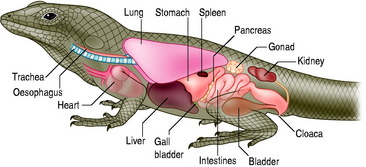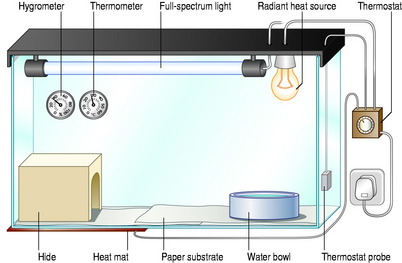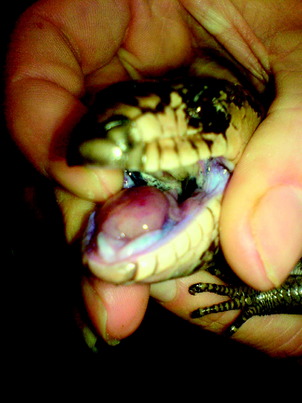Chapter 7 Lizards
A wide variety of lizards are available in the pet trade. The commonest species encountered are described in Table 7.1. The internal anatomy of a lizard is shown in Figure 7.1.
Table 7.1 Species of lizard most likely to be encountered: Key facts
| Species | Notes | Common disorders |
|---|---|---|
| Bearded dragons (Pogona vitticeps) | Medium-sized, characterful lizards. They do like it warm, however, and the hot spot should be up to 38°C during the day | Metabolic bone disease, Isospora and foreign body ingestion. Secondary infections often are the result of inadequate temperatures |
| Leopard gecko (Eublepharis macularius) | An ideal beginner’s lizard. Feeds well on supplemented insect prey including mealworms. Available in a wide variety of colour morphs, some of which carry very high prices | Cryptosporidiosis and foreign body ingestion |
| Crested gecko (Rhacodactylus ciliatus) | Popular because of its looks and wide natural colour variations, this gecko’s wild diet is rich in fruits and so it can be kept using commercially available foods rather than live foods | Metabolic bone disease is occasionally seen, as is a muscular-dystrophy-like disease often mistaken for MBD |
| Green iguana (Iguana iguana) | A large stunning lizard as an adult, its vegetarian diet makes it prone to calcium deficiencies | Metabolic bone disease, abscessation (secondary to prolonged low environmental temperatures and aggression-related behavioral problems |
| Veiled chameleon (Chamelo calyptatus) | Chameleons are generally not good starter lizards, but the veiled chameleon, providing it is offered water via a spray and given supplemented foods will often do well | Metabolic bone disease and dystocia |
Ultraviolet exposure
Nutritional supplementation
Crickets, locusts, waxworms and mealworms are commonly fed to lizards not because they are nutritionally good, but because they are easy to farm commercially and they trigger normal feeding in insectivorous species. Insects are inherently low in calcium and so this must be balanced with commercial calcium supplements. These are applied to the insects either by dusting a calcium-rich powder on to the prey, or feeding it upon a calcium-rich food. Note that many commercial calcium supplements also contain vitamins, including vitamin D3, as well as amino acids.
Consultation and handling
Sexing
Many lizards are sexually dimorphic as adults and can be readily distinguished, typically by the presence of pronounced pores cranial to the cloaca (pre-analpores) or medial thigh (femoral pores), combined with the presence of hemipenile bulges caudal to the cloaca (Fig. 7.2). Male veiled chameleons have a caudal spur on each hind foot, present from birth.
Nursing care
Provide appropriate environment including provision of:
Fluid therapy
Reptiles lack the Loop of Henlé and are, therefore, unable to produce hyperosmotic urine. Uric acid is excreted instead of ammonia; this is sparingly soluble and can be excreted at high concentration with minimal water loss as a sludge or paste.
Selection of fluids for reptiles
Nutritional support
Liquidized normal diet or proprietary support diets can be used, given either by stomach tube or by oesophagostomy tube.
Table 7.2 Lizards: Analgesic doses
| Analgesic | Dose |
|---|---|
| Buprenorphine | 0.005–0.02 mg/kg i.m. every 24–48 h |
| Butorphanol | 0.4–2.0 mg/kg s.c., i.m. b.i.d. |
| Carprofen | 1.0–4.0 mg/kg s.c., p.o. every 24–72 h |
| Ketoprofen | 2.0–4.0 mg/kg s.c., i.m. every 24–48 h |
| Meloxicam | 0.1–0.5 mg/kg s.c. p.o. every 24–48 h |
| Morphine | 0.05–5 mg/kg i.c. every 6–8 h |
| Pethidine | 2–4 mg/kg i.c. every 6–8 h |
Analgesia
Anaesthesia
Skin disorders
The epidermis of both lizards and snakes consists of two layers:
The dermis which is mainly connective tissue – may contain bony plates termed osteoderms.
Differential diagnoses of skin disorders
Erosions and ulceration
Nodules and non-healing wounds
Changes in pigmentation
Findings on clinical examination
Investigations
Table 7.3 Lizards: Thyroid levels
| Species | Total T4 nM/L | Total T3 nM/L (Free T3 pM/L) |
| Sceloporus undulatus Adult | 11.1–13.1 | 3.1–3.2 |
| Ameiva undulata Adult | 8.2 | – |
| Dipsosaurus dorsalis Adult | 3.2–14.5 | – |
| Dipsosaurus dorsalis Hibernating adult | 1.3 | – |
| Dipsosaurus dorsalis Adult (spring) | 13.0 | 0.5 |
| Trachydosaurus rugosus Adult | 3.0 | 0.3 |
| Podarcis sicula Adult | – | 0.15 (1.7) |
After Hulbert (2000).
Treatment/specific therapy
Respiratory tract disorders
Treatment/specific therapy
Gastrointestinal tract disorders
Disorders of the oral cavity







